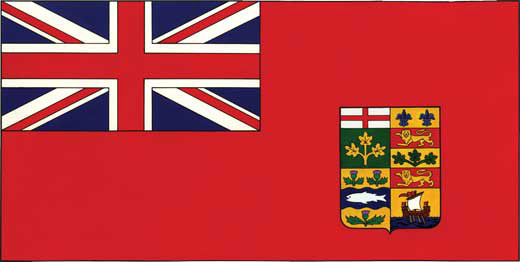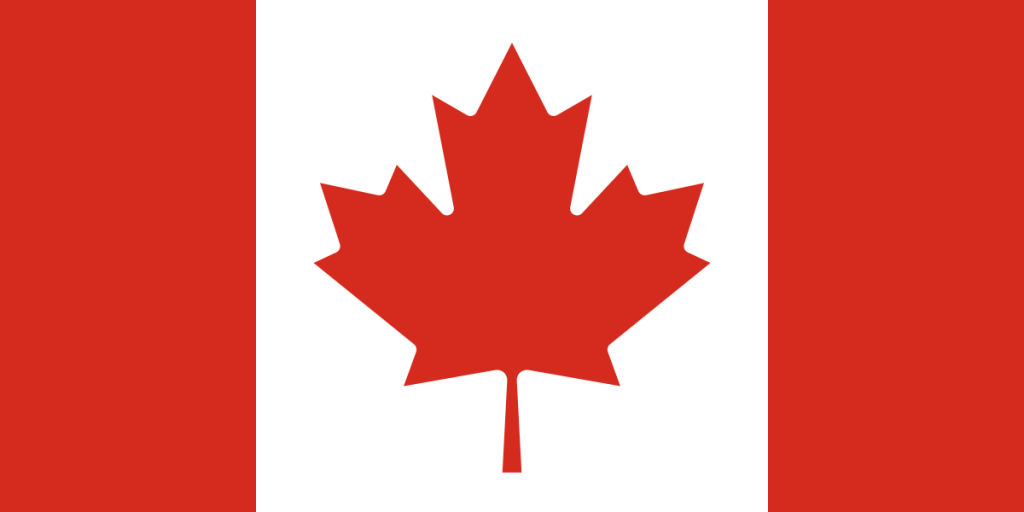The Royal Union Flag (Union Jack)
Several unique flags have been used to represent Canada over the years.
The flags of France and England were once both displayed. Before and after Confederation in 1867, Canada often used the United Kingdom’s Royal Union Flag, commonly known as the Union Jack, as an official flag.

The Canadian Red Ensign
The Red Ensign was officially a naval flag used by Canadian ships starting in the 1890s. The Canadian Red Ensign — a combination of the Union Jack and the Shield of Canada — had been used unofficially both at sea and on land since the 1870s and was widely recognized as Canada’s National Flag. There were many versions of the flag that included additional elements such as wreaths of maple leaves, crowns, and beavers. The shield itself was modified to include the arms of the provinces as they joined Confederation. During the First World War, the Canadian Red Ensign became a very popular patriotic emblem.
As Canada matured as a nation, it became more important to create uniquely Canadian symbols to represent the country.
In 1921, King George V granted Royal Arms to Canada and the Shield of Canada’s new official Coat of Arms took its place on the Canadian Red Ensign. It is this version of the Canadian Red Ensign that represented Canada during the Second World War.

Pearson’s Fixation on a New Flag
In the years following the Second World War, a number of Canadians, led by Lester B. Pearson, actively promoted developing a new national flag to replace the Red Ensign.
This was a very controversial topic and it divided the nation.
Canadians had fought and died under the Canadian Red Ensign flag and were proud of what the Red Ensign represented. Others felt that the Red Ensign did not represent Canada’s independence from England, or the wide diversity of people that helped build the country.
Creating a New Flag 1960-1965
In 1960, Lester B. Pearson, then Leader of the Opposition, declared that he was determined to solve what he called “The Flag Problem.” To Pearson, this issue was critical to the Liberal party and to his definition of Canada. After his election as Prime Minister in 1963, Pearson unilaterally announced that he would have a new national flag in place in time for Canada’s centennial celebrations in 1967.
Pearson began by proposing a concept for a new flag featuring a sprig of three red maple leaves, similar to those in the national coat of arms, on a white background bordered by two blue stripes, representing ‘From Sea to Sea.’ The heraldic expert and artist Alan Beddoe took Pearson’s concept and developed it into a design that became known as the “Pearson Pennant.”

Pearson recommended this design to members of Parliament in 1964, but his proposal was strongly opposed by Liberal Members of Parliament. Instead, a parliamentary committee was created and given a six week deadline to submit a recommendation for a national flag. Debate within the committee was fierce, divided between those who wished to retain the symbols that Canadians had fought and died over and those who wanted to adopt a flag to promote the Liberal party’s vision of Canada. This period was known as the Great Flag Debate.
1965: A New National Symbol is Raised
The new Maple Leaf Flag was made official by a proclamation from Queen Elizabeth II on January 28, 1965. On February 15 of that year, it was inaugurated in a public ceremony on Parliament Hill. Thousands of Canadians gathered as the Canadian Red Ensign was lowered and, at the stroke of noon, the new National Flag of Canada was hoisted. Prime Minister Pearson’s words on the occasion resound with hope and determination: “May the land over which this new flag flies remain united in freedom and justice … sensitive, tolerant and compassionate towards all.”
In 1967, the year of Canada’s 100th birthday, our new flag was showcased to the world at Expo 1967.

Controversies still remain
For several years after the Maple Leaf became Canada’s official flag the Canadian Legion, among others, either refused to fly the flag or flew it reluctantly. They felt that the new flag failed to represent the people who fought and died for Canada in the Boer, First and Second World Wars.
Still today there are Canadians who refuse to fly the flag as they feel it represents the current federal government rather than Canada as a whole.
This is unfortunate as in the nearly 60 years that the Maple Leaf has been Canada’s flag it has risen above politics and become a true symbol of our great nation.
Red Ensign
The Red Ensign was a symbol of bravery and heroism during the World Wars. Canadians, with Red Ensigns behind them, fought against Nazis in World War II.
The Red Ensign should always be viewed with reverence, including as a remembrance of the brave soldiers who fought for Canada, and for the freedom and liberty for many.
Both Flags
As Canadians we all have so many reasons to celebrate and be proud of both flags. The Red Ensign that honours our past and the Maple Leaf that allows us as Canadians to look to the future.